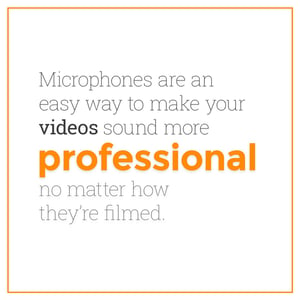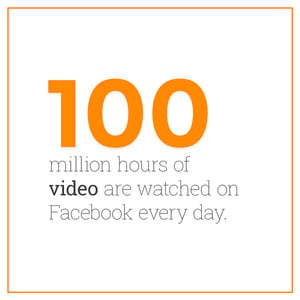Video Marketing:
The Marketer's Guide
What is Video Marketing?
Anytime you press record with the intention of getting closer to your business goals, it’s with video marketing.
From Snapchat stories and live social media, to the most highly polished corporate webinars, video marketing comes in every imaginable shape, size and format. Think about your other marketing content: blogs, infographics, ebooks, social media updates and more. That same content, turned into a simple iPhone video, gets you into the video marketing game.
Why Now?

In a world full of fake news, adverts, automation and chatbot customer service, it’s never been harder to earn the trust of consumers. It’s no wonder people are craving the human interaction and authenticity of video.
Video has been the most popular, powerful communication medium in the world, ever since its invention. So why is it now spreading like a DIY marketing wildfire? Because YouTube, smartphones and social media have all made videos incredibly cheap and easy to access or create.
More than 180 million internet users watch online video content every month and that number is growing rapidly every year. That’s a lot of people who could see your message or learn about your products and services.
But are Videos Right for Your Business?
Absolutely yes.
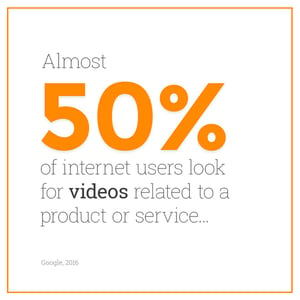
No matter what your business does, videos are as essential to your marketing as a website or a blog. If videos don’t seem like the right fit, it’s likely that you’re just picturing the wrong kinds of marketing videos.
There’s no marketing on the planet getting a better ROI than video (Adobe, 2015). But those videos are incredibly varied in almost every aspect. What works for your business will be specific to your buyer personas and brand.
Start discovering the right direction for your video marketing, from budget to format, in this information guide explaining the basics of: preproduction planning, filming, editing, publishing, optimizing for search engines and growing your audience.
What are you waiting for? Your audience is out there.
Get Started: Preproduction.
Successful video marketing strategies begin with careful planning. Walk through these easy-to-follow steps to consider every important aspect of your videos before you hit record.
Determine Your Purpose
Before you can begin to hash out the details, determine what the main goal is and how it ties into your marketing goals. For example, if you wanted to grow your restaurant’s dinner business, the purpose of your video could be to showcase your awesome daily dinner specials.
If your marketing goal is to get more clients by showcasing the expertise of your doctors, a good video could explain how to treat a simple medical condition and know when it’s time to see a professional.
CTAs: Plan the Next Step
Ok, so now that you know what to film, it’s time to determine what action you want viewers to take after watching. Should they visit your website for more information? Sign up for weekly emails? Request a free consultation? Download a coupon?
The call to action to use (and every marketing video should ALWAYS include one) really depends on your business, the purpose of your video and where this content fits within the buyer’s journey.
Build Your Video into the Buyer’s Journey
Like any content, your video marketing should always target a specific buyer persona. (Download this free ebook for more info on creating those.)

Once you’ve chosen a persona and can use that to guide your tone of voice, you’ll need to make sure your video is also targeting the right stage in the buyer’s journey. You should always be trying to help buyers achieve their own goals, or solve their problems, not selling. Yet, depending on what stage they’re in of the buyer’s journey, they may not even even have a name for their problem yet.
Use these quick guidelines to make sure you’re creating the right video content for your buyers, at the right time:
Awareness Stage
Your buyer wants to solve a problem, find a solution or fulfill some kind of need. The important thing in this stage is to help them recognize what they’re looking for by providing helpful answers, insight and expertise.
- Short format (30-90 seconds)
- Helpful how-to content
- Fun company culture videos
- Inspirational, motivating content
- CTAs leading to more in-depth content locked by landing page forms
Consideration Stage
Now your buyer is busy researching solutions and considering options for solving their problem. It’s time to showcase your solutions, explain why they would or wouldn’t be a good choice and build their relationship with your brand.
- Short or long format (2 - 10 minutes)
- Informative and entertaining
- Explainer videos
- Product demos
- Testimonials
- Case studies
- CTAs leading to decision-based content
Decision Stage
Finally, your buyer is ready to make a purchase. They’re just deciding on what specifically to purchase and from who. Your job is to make this a no-brainer with details, unbiased reviews, guides and discounts.
- Short or long format of any length
- FAQ
- Testimonials, reviews and unboxing
- Instructional or in-depth product features guide
- CTAs for purchase-related offers and discounts
Bonus: Delight
This last step of the inbound marketing methodology isn’t a stage of the buyer’s journey because technically, this stage happens after a purchase. Yet it’s an awesome opportunity for video marketing. The goal here is to make your current customers so happy that they’ll become brand promoters. Let loose and have some creative fun with these videos, you have a lot less to lose here than in any other stage.
- Short and sweet is best (live is great too)
- Thank you videos
- Customer support video shorts
- Product update demos or new product sneak peeks
- Tips, tricks and hacks
- Just for fun brand videos
- CTAs related to your topic or linking to more fun content
For an in-depth look at video planning for each stage of the buyer’s journey, check out this blog by our own video marketing experts!
Creating Your Preproduction Plan
Use these guidelines to save time by outlining a page or two of important details in advance (and sharing them with key stakeholders).
- Why: Write and share your video purpose with the whole crew to keep your efforts on track and your whole team on the same page.
- Who: Determine who will be on camera and behind the camera, as well as who will be editing, publishing and promoting the video. If you’re filming more than one video per day with the same people, it’s a good idea to have them bring an extra shirt or two for variety.
- What: This is the play-by-play plan for your video including script, post-production graphics and music, special effects and art direction. A paragraph or two of direction is usually all it takes to capture the details of a low-budget business marketing video.
- Where and When: Plan for the best time of day for lighting in each location, as well as rain dates as needed. Marketing videos are often done indoors in your own office, without a lot of frills. So lighting may not be a factor, but you may want a time of day when they’re less foot traffic and interruptions. Remember to give everyone ample time to ensure they won’t be rushed or panicking to get it right.
Choose Your Format
It’s not enough to decide you’re going to make a video for your business marketing. There are three main and very distinct formats that each come with different restrictions and advantages: live, short and long formats. Since they all serve a different purpose, try using a mix of all three in your overall marketing strategy, or even within one campaign.
Live Video
This new addition to the video marketing arena is simple and increasingly popular. Live videos begin broadcasting instantly on social media channels, such as Facebook or Instagram, with the push of a button on your smartphone or tablet.
They’re a great way to interact with your channel-specific social media audience in a fun, informal format and see who’s tuning in as it happens. However, these shouldn’t be your only format of marketing videos as they include drawbacks that don’t affect other formats.
Here’s our take on the pros and cons:
- Con: Mistakes without mulligans. Be prepared to roll with whatever happens.
- Pro: Real-time engagement. Interact with users as they join or comment, instantly.
- Con: No fancy editing allowed. Actually, no editing is available at all. That includes cool special effects, other than filters available through the social media channel you’re broadcasting on.
- Pro: Reduced costs. These videos are made using smartphones, tablets, or webcams, usually without scripts. So you won’t need professional equipment, a professional videographer or software.
- Pro: Faster results. There's a sense of urgency with LIVE video that makes your audience feel like they need to watch it right now, even if it’s available forever (and it can be depending on the platform). Since there’s also no production time, you can start getting an audience the second you press “record.”
Short Video
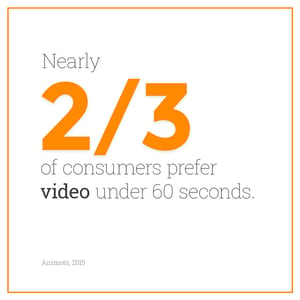
We’re busy, we’ve got short attention spans and there’s just too much content in the world. Whatever the reason, short video gets great engagement with an increased chance that consumers will watch past the first 10 seconds, a big challenge for video marketers.
Short video allows your business to highlight a topic, summarize a written webpage and create a low-cost, low-effort piece of content to aid your inbound marketing efforts, like the video version of a blog. If you can’t say everything you need to in order to provide value, insight or help your consumers solve a problem, use short videos as a teaser for your written or graphic content.
Here’s our take on the pros and cons:
- Con: Limited time. That means limited information too. So you won’t be able to use a short format for everything.
- Pro: Quick and easy. Short videos require less time, resources, planning and frills. So you can produce more, faster.
- Con: Value takes creativity. You need some serious strategy to make a >60 second video a powerful experience or valuable piece of content.
- Pro: Higher engagement. More people are likely to watch short videos, and for longer.
Long-Form Video
Video can be used like any other original long-form content offer you create. Build a campaign and landing page around it to increase your conversions and meet marketing goals. Or if the information is valuable enough, you may even decide to charge for viewing access.
Here’s our take on the pros and cons:
- Con: More planning. Longer videos require a lot of planning and production effort to be engaging and well-structured the whole way through. That also means more editing and bigger budgets.
- Pro: No limits. Since there’s no time limit, the only restrictions on this content is your creativity and budget. Want to teach your audience how to do their own oil change, as a musical? You can do that.
- Con: Go niche or go home. Only people who really want your information are going to watch a long-form video. So plan to target specific buyer personas at specific stages of the buyer’s journey.
- Pro: More value. If your long-form video provides a lot of valuable information, it has the potential to make a larger impact on your marketing goals, for years to come.
Video Scripts
It’s not usually a good idea to go unscripted for your first few marketing videos, especially if your team doesn’t have a lot of on-camera experience. Even a short, simple script will calm the nerves of on-camera talent and provide direction for the whole crew.
Use the tips below to create your own custom script.
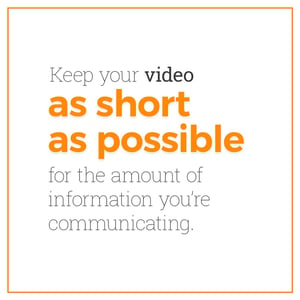
Tips and Tricks to Create Your Custom Script:
- Denote who’s speaking and whether or not it’s voice over.
- The two big pieces of a video marketing script are descriptions of video and descriptions of audio.
- VO: In a world where spaghetti robots are everywhere….
- Tom: Here are 5 safety tips to avoid party hat disasters.
- Time your dialogue and estimated other footage to get a total runtime.
- Include instruction for stage direction, art direction, b-roll footage, pans, zooms and other visual specifics.
- Include the full, spell-checked text of opening or closing text, titles, credits, etc.
- Do you want captioned text added to the video during editing?
- This could drastically improve social media views and search visibility for your videos.
- Include any music or audio effects.
- Include any special video effects.
- Keep it simple.
- Include a relevant call to action designating the next step a viewer should take.
- Stay as short as possible for the amount of information you’re communicating.
- Practice reading your script aloud a few times to be comfortable on camera.
Get Shooting: Production.
Arm your video team with the right equipment for your goals, without spending a fortune. Explore the tools and price options below, before you shop, to get a full picture of what you’ll need and what you won’t.
Assemble the Right Tools
Lenses
These add-on tools work with your camera, iphone or smart device to change your camera’s perspective. Although your camera or device will already have a built-in lense, additional lenses allow you to zoom in closer, get wider, shoot in portrait mode or add artistic filters.
Cameras
Plan to shoot all of your videos with a digital camera capable of recording in high resolution. But none of that means you have to go purchase pro equipment. If you’re just starting out and doing-it-yourself, an iPhone, iPad or other smartphone or tablet is a great option. In fact, many marketing videos are made that way!
Once you’ve gotten a decent video library, learned some technical skills and are ready to try out the next level of camera, a digital camera with a built-in lense is a good next step. Though you might be tempted to invest in lots of fun features, try to balance frills with ease of use. Many of these are all setup and ready to shoot out of the box.
Pro options for detachable lense digital cameras (DSLR) are almost endless. Like any big tech purchase, be sure to do your research and invest in something that will:
- Keep up with rapidly changing technology for a while
- Not exceed your skill level so far that it’s a hinderance
At this level high price range, many videographers prefer to change out the default lense for a custom option.
When you’re considering a pro camera purchase, ask:
- Is a microphone plug included?
- Will I need additional software?
- Will I need additional adapters?
- Are aftermarket extras inexpensive and readily available?
- What’s the recommended skill level?
- What’s the recommended use?

Tripods
Even if you’ve decided to start small and shoot video on your iPhone, a tripod is essential to making your videos stable, high quality and professional.
Generally, the type of camera you’re using will help to narrow down your tripod options. Consider whether you’ll be upgrading to a big camera, panning or tilting, and if you’ll need a full-size solution rather than a smaller version you’ll need to place on furniture.
For the most inexpensive solution, a compact tabletop tripod is a great choice.
Pro Tip: Make sure to purchase a smartphone or tablet mount separately if your tripod doesn’t include one.
Microphones
If you’re going to buy just one piece of equipment, make it a microphone. Viewers can usually forgive low-quality video, but bad audio is a deal-breaker.
From single clip-on microphones to high-quality kits, microphones are an easy and often inexpensive way to make your videos sound more professional, no matter how they’re filmed. Whether you choose wired or wireless, be sure the audio cable is compatible with your camera or phone or purchase an adaptor separately.
Lighting
Nearly all smartphones and cameras include some kind of light, but you’re not likely to use it. Generally, those lights weren’t meant for most styles of business marketing videos.
There are a lot of options for expensive lights, stands and inexpensive reflectors or smaller lighting models. Whether or not additional lights are necessary depends on:
- The type of videos you plan to produce
- Natural and artificial light options in spaces available to you
Teleprompter
This simple tool is often overlooked until you start filming and realize how badly you need it. Don’t try to memorize everything you need to say, but on the same hand, don’t feel like you need to invest hundreds on a high tech teleprompter.
The cheapest and most simple option is still good, old-fashioned poster board, held by a teammate off-camera. However, if you’re going to be filming more than one video over the course of business, a small multi-purpose investment is a great idea. Consider using an iPad mini or similar tablet that’s mounted or placed near the camera.
Filming with a Smartphone or Tablet
There’s absolutely nothing wrong with using the camera that’s already in your pocket. It’s actually pretty high tech. Don’t invest in a lot of expensive equipment before you film your first video. Start small by shooting with your smartphone or tablet. You’d be surprised how many professional videos are made the same way.
Use these phone-centric filming tips to get started:
Stabilizing
Don’t rely on editing tool stabilization. A low-cost tabletop tripod, or even a stack of books, will keep your iPhone or iPad still and steady.
Landscape vs. Portrait
If you can, shoot horizontally for better a widescreen experience and less of a risk you’ll have to crop it later.
Zoom
Don’t do it. Just don’t.
Yes your phone is capable of zooming in, but it will drastically reduce the quality of your video. Do yourself a favor and move closer to your subject or invest in a low cost zoom lense and adaptor that clips right onto your device.
Lighting and Flash
Unfortunately, lighting is another iPhone feature that just won’t cut it on your professional marketing videos. Use the best natural or indoor light you can to strike a balance, flatter your subjects and craft a professional look. If your lighting resources are sparse, invest in some low cost lighting or reflectors made specifically for DIY filming.
Best Practices: Production
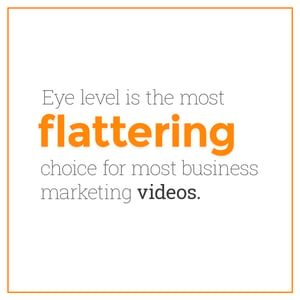
Angles
It’s easy to carried away by creativity. Just try not to let it affect it the angle you’re shooting your subjects. Eye level is the best, most flattering choice for most business marketing videos. Angling your camera too high will make your subject look small or weak, while too low can make them appear aggressive. For head-on videos of people speaking directly to the camera, line the bottom of the shot up to be mid-chest with your subjects.
Feel like experimenting with angles? Try it first while shooting landscapes and b-roll.
Audio
Echos and reverb can make your video sound sloppy. So test your sound in advance and avoid shooting in an empty room. If you don’t have location flexibility, try adding soft furniture or hanging blankets from the wall.
Even an inexpensive clip-on microphone, called a lavalier, can drastically improve sound quality. Don’t be afraid to ask the people you’re filming to hide the wire under their shirts so it doesn’t become a visual distraction. Place clip-on microphones about 6 inches below the speaker’s chin for the clearest sound.
B-Roll
Ever notice the supplemental shots before, after and in between on-camera interviews? This important resource for video editors is B-roll and it’s a great way to fill in gaps of space while adding visual value.
Be sure to stock up on B-roll footage for a more professional feel and better variety to choose from during editing. Create your own to use whenever you need it by scanning or recording anything or anywhere that’s relevant to your business or video topic. For an even greater variety, explore online sources of stock B-roll footage.
Ever wanted an excuse to get a drone? Creating aerial B-roll footage is a great one!
Take 2 (or 10) Retakes
Every heard it’s better to be safe than sorry? It’s a lot harder to set up an entire shoot twice than it is to record the same footage a few times. Never assume you can fix anything in editing.
Get Polishing: Post-Production Editing.
Editing is totally doable for even the novice video marketer and comprehensive enough to require a lifetime of mastery.
You just don’t know what you don’t know. And that’s ok.
The level of post-production you’ll need will vary a lot depending your video format. Generally, the more time and effort you invest in making a video, the more likely it will need the professional polish editing provides.
Review the best practices below to get a base knowledge of video editing. Once you understand where you’ll need to fill in skill gaps for your video team, you can easily target the right educational resources online.
Editing 101: Best Practices
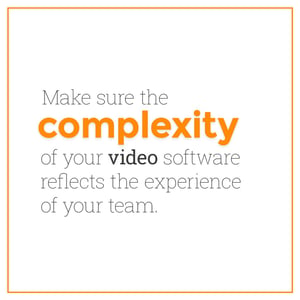
Editing Software
Just like production equipment, you should start out with an editing software that’s free or low-cost and easy to use. It’s easy to get excited about frills and special effects while you’re shopping and comparing, but you may not have the skills required to use those features yet.
Make sure the complexity of your editing software reflects the experience of your team and video format. For example, live social media videos don’t get any opportunity for editing. Smartphone and tablet videos can be simply edited right on the same device they were recorded with, using built-in features and aftermarket apps.
Check out 9 free video editing software options in a blog by our friends at HubSpot before you consider investing.
Import
Connect your camera, smartphone or tablet to your computer via USB, then transfer your raw footage to file you can easily find and work from. Be prepared to wait for larger files.
If you’re unable to connect via USB to the computer you’ll be using to edit footage, use an online file sharing program to upload and download files. Many are even available via mobile app, such as Dropbox.
Organizing
If your video is longer than a few seconds, you’ll be glad you took a little time to name and organize your files. Create subfolders for your clips in whatever convention makes it easiest for you to find what you’re looking for.
Trimming and Arranging
This is probably the first thing that comes to mind when you think of editing. Although the details vary depending on the software you’re using, the basics are fairly standard.
Editing software will allow you to arrange and cut video clips on a master timeline or sequence, usually by dragging and dropping files where you want them to appear. Add transitions and B-roll between clips the same way, to create a smooth, logical flow. Remember to keep transitions simple and relevant to the style of your video. They should glue everything together without standing out.
Titles and Graphics
Use the text editor of your video editing program to write, style and animate text for your video’s title, credits and captions. Drag and drop your styled text right into your master video sequence at the time signature you want it to appear.
Special Effects
As a general rule, don’t use too many special effects. In fact, don’t even think about them until you’ve got a basic skill level and the confidence of at least a few videos in your library. Focusing on special effects too quickly can be time consuming and unnecessary.
If you really want to experiment with fun special effects and filters but don’t have a lot of technical editing skills, record some videos on Snapchat, Facebook, Instagram or a similar app with those features built right into the recording program.
Audio
Sound can take your video to the next level of production value, but can also be extremely tricky to master. You’ll need to ensure that the volume of voices, music and sound effects are all at the same level.
Most video editing software includes controls to fade audio in or out and add it directly into your video’s master sequence.
Pro Tip: Be sure to only use royalty free music or you may face unwanted legal action.
Exporting
You’re almost ready to post and publish, but there’s one more important step that can drastically affect your video quality.
At this point, your finished video is probably a very large file containing video, audio and even text. It’s too big to upload it as is, so you’ll need to use your editing software to compress it into a file that’s small enough to post, but large enough to retain a high quality.
Check the specific video-hosting channel for specific file size guidelines. You’ll also want make sure you’re using the right file type.
Unsure of where to begin? Use these links for a general idea:
Check with your specific host for guidelines on uploading videos to your website or blog.
Get Optimizing: Video SEO.
Video represents a unique place in the SEO world. While the contents of a video itself aren’t indexed by search engines, at least not yet, the metadata ascribed to the video is. Companies who want to use video as part of their SEO strategies need to use a combination of traditional SEO techniques as well as new techniques that target video SEO.
Adding video to an existing SEO campaign is more about understanding how video and SEO work together than changing your current SEO practices altogether.
Video SEO isn’t a side strategy for a successful business, it’s a direct line to a huge chunk of the consumer market.
SEO Starts with Great Content
Before you can begin to optimize your videos for search engines, you need great video content that people want to watch. However, great videos don’t need to be epic productions or even the next viral sensation to be successful.
These five types of videos are proven to work for any type of business:
- Company or product profiles: Short, sweet and to-the-point clips are a versatile showcase of who you are and what you do.
- Customer testimonials: Let your customers do your selling for you by talking about their experiences working with you.
- Video news releases: Take the standard press release to the next level with a short video message about your news and why it’s important.
- Employee profiles: Put a human face on your company and let employees’ passion come through to your customers
- Product demos: If you sell a product, show it off. Consumers who watch a video about a product are 52% less likely to return the product after purchase.
Start Ranking in Search Results
Incorporating video into your SEO strategy is pointless unless your videos can be found by search engines, so your next step is to ensure that Google and other search engines can, and do, index your videos properly.
Optimizing Titles, Descriptions and Metadata
There are three basic elements of video search engine optimization that must be used in conjunction with high quality video content: video title, description, and metadata. Brands can create the most stellar videos on the web, but if these basic elements are not optimized as well, no one will ever discover the content.
The title of your video shouldn’t just be catchy, it should also be descriptive if you want viewers and search engines to know what the video is about. A title such as “Product Overview” might make sense in the context of a larger page, but will that be effective on its own? Whose product is it? What is the product? Instead, tell potential viewers what the video is about with a title that gives search engines the context required to start indexing the video properly.
Pro Tip: Even descriptive titles suffer from being too long.
The next step is crafting a description that completes the picture. Descriptions are crucial to video SEO. A video description should be written to attract the attention of search engines and consumers. Write your description like a movie trailer, giving enticing info about the content without spoiling the end. Phrases like “You won’t believe what happens next,” may sound cliché, but they work to encourage consumer clicking. Integrating keywords throughout the video description, or adding meta tags to a video, will help search engine algorithms assess the video’s content.
Video increases the chance of a front-page Google result x53, so a strategic video description and message are crucial to your success.
YouTube and other video upload sites allow (and require) you to include other metadata with your video. Data including genre (required), date filmed, author, company, location and keywords help to further cement your video into search indexes in the context you want.
Don’t just skip or rush through picking the right keywords for your video. Take time to make sure you have the right words with your post. This doesn’t mean that you get to fill the space with every imaginable keyword, use the words that are most meaningful to the video you are uploading. Consider adding a transcription of your video as another way of sharing the content, often a necessary step for creating subtitles.
Thumbnails Shouldn’t be an Afterthought
When someone is searching for a video, they’re likely to be looking for your video among a sea of other videos and video thumbnails, so you need to make sure your video stands out from the crowd. A video in universal search results has a 41% higher click through rate compared to its plain text counterparts, if your video and associated thumbnail are enticing, so make sure they are!
Thumbnails can be screenshots from the video content or they may be created separately to advertise the video. If your thumbnail is boring, blank, or difficult to make out, people may not click your video. All video sharing sites, including YouTube, allow you to pick from several different thumbnails from your video. While the default choice might sometimes be perfect, it often isn’t. Take a moment to consider all of your options and choose an image that represents your video well.
Video SEO Tips for Your Website
Once your YouTube channel is customized and fully fleshed out, you’ll need to apply some of the same steps to your website as well, to give your SEO efforts an extra boost and context.
Here are four easy steps to extend and enhance the SEO strength of your videos (and website):
Embed Your Videos in Appropriate Pages
Your YouTube channel is a great warehouse for all your videos and will help Google understand more about your company as a whole. But make sure you embed your videos on your own website as well. This helps Google to see not just the video, but the context of related content. Embed your videos on the appropriate pages of your website to not just enhance the content there, but to make those connections between the video and the point you’re trying to convey.
Video Library or Gallery
A video library or gallery page that lists all of your brand’s videos in an organized fashion is a great tool for visitors and search engines alike. On your own page you have freedom to describe, organize and categorize your videos beyond YouTube’s imposed hierarchy. A video gallery gives you the same opportunity as your YouTube channel and playlists, but also caters to the segment of your audience that doesn’t visit YouTube.
Thumbnails
The thumbnails of your video can either inspire clicks or send potential customers on their merry way. The video thumbnail is usually a frame of the video itself. If, however, your thumbnail features a boring frame such as a blank screen or a surplus of words, consumers may assume that the video is uninteresting. Choose thumbnails with action, color, and excitement.
Add Clear, Thorough Descriptions
Be sure that all of your videos have keyword-rich descriptions that communicate precisely what the video is about. Descriptions should appeal to search engines and consumers, so a teaser at the end may increase video clicks.
Optimizing Video Landing Pages for Search
Optimizing your video landing pages for search involves many of the same techniques and practices common to content search engine optimization. Keywords should describe the specific video and the message on the page itself, and not be filled with extraneous, irrelevant keywords.

Be SEO smart and only use the words that match the content. Using video social media sites, like YouTube, is a great way to research popular search strings. When you type in a keyword, YouTube will provide a list of common phrases associated with that word.
Add transcripts of any videos that you post to your website. Since Google and other search engine algorithms are incapable of assessing the content of a video, a transcription document provides a search engine (and human) friendly version of your video content that can be indexed.
Including widgets for popular social media sites such as Facebook, Twitter, and Pinterest will make it easier for consumers to share your videos with their friends and followers. Social media activity is a great rankings booster as Google is also using the number of times a video has been shared as a ranking factor.
Creating a Video Sitemap
If your website is filled with videos, but you’re simply not ranking for them, there may be an issue with Google’s ability to evaluate the video content on your site. Solve that problem by creating a video sitemap. Google enabled sitemap protocol for video content in 2007. Creating a video sitemap will tell Google precisely where all of your videos are located and what the content is in each video.
A video sitemap is, in essence, a text document that utilizes officially recognized Google sitemap protocol. This text document will have specific video tags embedded within the text. Use Google Webmaster tools to create a sitemap for the videos on your site to be walked through the process with easy-to-follow steps.
Incredibly, each sitemap allows you to provide information for up to 50,000 video files. Use tags within the sitemap document to state the location of the video landing page, specific video URL, recommended video player, recommended thumbnail for your video, a title and description, video length and even encode alerts that will tell users whether or not content is appropriate for all ages.
Measuring Results
Just like any search engine optimization strategy, it’s important to measure the results of your video content. Use Google Analytics to see how your website is ranking with Google and track your video views.
If you’ve developed a specific landing page for video content, it will be easy to determine whether or not your video content is effective in generating site activity. Given that landing pages with video are known to generate four to seven times more engagement and response rates, you should see a considerable boost.
Check your social media accounts to see how often videos were shared via Facebook, retweeted via Twitter or viewed on YouTube. Watch the trends including time of day and day of the week when looking at your data to see if you can get better results by changing when you post and share videos.
Keep a record of different videos and the response each generated to help you understand what types of videos and content performs well within your target audience.
Get Publishing and Promoting: Build an Audience.
So, you’ve finally published a bunch of videos for your business. Great! Now, how do you get people to actually watch them? Just like blogs, or any other inbound-angled marketing, videos need strategy to fuel their success.
Use these publishing and promoting guidelines to get the maximum mileage out of your video marketing.
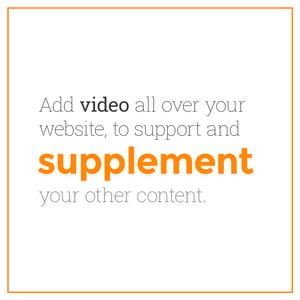
Publishing to your Website and Blog
Add video all over your blog and website, to support and supplement your other content. Just be mindful of how you’re adding it.
No matter what content management system (CMS) or server is hosting your website, you’ll typically have two choices for adding video: uploading or embedding with code.
Uploading your video files directly may seem like the easier option, but you’ll be using up limited bandwidth and limiting your ability to share your video in other places. After all, your website wasn’t created to be a video hosting server, so it’s not built or optimized like one.
Instead, consider uploading your video to a video-hosting website such as YouTube, Vimeo, Wistia or Vidyard. Then, just click the video’s sharing button to view it’s embed code. This code (or codes) can be copied and pasted to directly into your website CMS or blog to generate a copy of your video anywhere you want it to appear.
Anywhere it’s pasted, your video should retain the same features it has on the video-hosting site it’s sourced from. Anyone should be able to share it with ease.
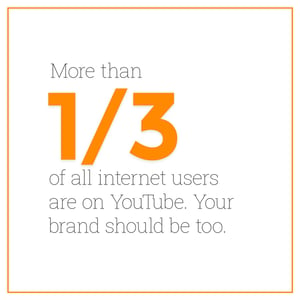
Publishing on YouTube
While there are other places to upload videos, more than one third of all internet users are on YouTube. So your brand should be too. It’s easy to create a YouTube channel for your business, but optimizing its performance is another story.
Use this step-by-step guide to upload your videos to YouTube after exploring the tips and tricks below.
YouTube Publishing Best Practices:
- Create a YouTube account linked directly to your business email, or create a business account, not your personal email.
- Create and customize a YouTube Channel to host your growing library of marketing videos
- Once your video is uploaded, choose to publish it right away or schedule it for a later date. Be mindful of your subscribers who will receive a separate notification for every video you upload.
- Start with a short, basic name for your video and let YouTube autocomplete it. (It’s ok to have the same or similar name to another video.)
- Create a custom design for your channel page with your own header, brand logo, company name, background, links to your website and links to your other social media channels including Twitter, Facebook or LinkedIn.
- Switch up your format to keep your subscribers guessing. If you usually post short format videos, try throwing in one long-form, content-rich video per quarter. You can also use long form content as the base of a video marketing campaign that you support and promote with shorter videos.
- Change backgrounds or locations to keep your videos from getting visually stale.
- Use a custom thumbnail to further integrate your branding into every detail of your YouTube channel, videos, even the web browsers of your audience.
- Add annotations with YouTube’s easy-to-use annotation tool in the Video Manager. Check out this annotation tutorial blog from our friends at HubSpot for a step-by-step guide.
- Ask people to subscribe at the end of every video. Give them an enticing reason as simple as “get alerted of more content just like this.” Then, make it easy to subscribe by using annotations to direct viewers to your subscribe link.
- Be authentic! Don’t forget the big reason people like videos: they’re real. Use your flaws, personality and natural mannerisms to bring a sense of humanity to each marketing video.
Video Promotion and Publishing on Social Media
According to a TechCrunch report, 100 million hours of video are watched on Facebook every day. That’s a lot of eyes, and even more opportunity.
A successful video marketing strategy will include publishing and promoting on all of your social media channels, in the same way you would use them to boost engagement with any other content.
Simply follow the guidelines below to get started leveraging video on social, then explore channel-specific information as your video library grows.
Social Media Video Promotion and Publishing Best Practices:
- Keep it short. There’s too much content on social media to focus on one thing for very long. It’s not meant to be consumed that way, so go with the fast flow of your social feeds.
- Include captions for silent autoplaying. Let’s face it, we don’t always want the whole world paying attention to what we’re watching in public (that’s if we’re not already sneaking in a little social media time when we’re not supposed to be.)
- Make all of your videos mobile-friendly. This is one of the most important ways you can optimize for social media. It’s also important to know that Facebook and Instagram favor square or even vertical videos, an easy adjustment you can make in editing.
- Optimize for each social media platform.
- Target a specific buyer persona and a specific stage of the buyer’s journey.
- Host your video library in different places for different users, but host then all on YouTube as well. Then, you can easily embed their links on your blog or website.
- Schedule your publishing to target the optimal day and time for reaching your target audience. A/B testing will help you to discover optimal times if you’re starting without a baseline.
- Promote your video posts the same way you promote all of your other content.
- Employ social media video best practices by platform:
- Keep your audio optional by including captions.
- Upload directly to Facebook for the maximum amount of attention from their algorithm, which heavily favors native content.
- Stay super short, from less than 15 seconds to less than two minutes.
- Videos here autoplay with no audio, so use captions and visuals to tell the story.
- This channel is all about imagery, so focus on making your videos look great.
- Square videos are key here.
- Experiment by linking several videos using Instagram stories for a longer form of video content that still fits within the platform’s popular formats.
- Use hashtags to help search engines and users find your content.
- Use this channel to post and promote ONLY business-centric or videos or those dealing with the issues of professionals.
- Great option for promoting webinars and video content that’s especially valuable to professionals.
- Not highly used as of now, this could be great opportunity for early adopters.
- Stay under 30 seconds.
- Mobile optimization is a MUST.
- Keep it fresh and relevant. Twitter topics get stale faster than any other social media platform.
- Hashtags are critical on Twitter, especially for topical subjects.
- Include text captions you’ve created in editing, since Twitter won’t create them automatically.
Going LIVE on Social Media
Once you’ve got a little video experience, or are just feeling brave, start experimenting with LIVE video on Facebook, Instagram, or Periscope (Twitter). Even though it’s relatively new, the popularity of live video is skyrocketing.
Try not to be overwhelmed by daily new features, like filters or split screen broadcasting, and focus instead on mastering the art of a smooth, successful live video without a lot of frills. Ensure that you have a good internet connection before the broadcast starts.
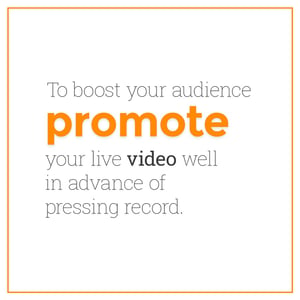
Although your live video will live on your social media channel long after you’ve stopped recording, the audience appeal of this format is to watch as it’s happening, and interact with the hosts via comments. To boost your live audience, promote your live video well in advance of pressing record. Make regular social posts including the details of who is going live, when and why, leading up to the event.
Facebook Live
Facebook Live allows you to stream video on mobile or desktop in real-time to friends and followers. Debuted in in 2015, this feature has a time limit of four hours. Just like Instagram, friends and followers are allowed to “react” and add comments during the stream so that you can interact with them.
The secret sauce to Facebook Live is planning. Hyping up your audience in advance can help you to build a bigger audience that’s ready to watch just as you hit that record button. There’s a few ways that businesses can plan out their Facebook Live promotion for maximum impact.
Some of our favorites include:
Social Media Channels: Announce ahead of time on all of your social media channels.
Email: Contact anyone that has expressed interest in your videos before, along with your blog subscribers who might find the live video content useful.
Team Members: Have your employees inform their followers and friends about it. Word of mouth is still a great promotional option.
When you’re finally ready to go Live, here’s how you do it: Tap the status box at the top of your news feed, labeled, “What’s on your mind?” Then, tap Live Video, write a description (optional), then click Go Live. Hit Finish to end your broadcast at anytime.
Or, go live in a group or event by tapping Write Something or Say Something and then tapping the Live icon.
Getting unwanted attention of the troll variety? Block viewers easily by tapping the profile picture beside their comment and click Block.
Instagram Live
Instagram Live, debuted in 2016, lets you broadcast video to your followers in real-time. Unlike Facebook, they can only watch while you’re still streaming. Viewers feel a greater urgency to watch IG Live videos immediately because they know it’s their only chance as there are no replays.
Here’s how you do it: swipe to the Instagram Stories camera. Instagram will choose some close friends who’ve shown interest in live video to hit with notifications to come watch. Both viewers and the host of the live stream can comment.
Time For Action.
Whether you’re going the DIY route, getting help from agency pros or doing a little bit of both, you’ve come to the right place. Like a lot of marketing, video can be an incredible tool for accomplishing your goals, or an incredible waste of time and money. Learn as much as you can to build your video library on a smart, successful foundation.
Have more questions or need some help with video marketing for your business? There’s no team more excited about video marketing than Impulse Creative. Reach out to us today and let’s talk about leveling up your video strategy.

